Trailing Edge Loss of Choked Organic Vapor Turbine Blades †
Abstract
1. Introduction
2. Denton and Xu Model
2.1. Staggered Trailing Edges
2.2. Real Gas Modification
2.3. Discussion of the Denton and Xu Model
3. Results
3.1. Test Section and Configurations
3.2. Flow Cases and Thermodynamic Data
3.3. Instrumentation and Data Reduction
4. Experimental Results
4.1. Choking Mach Number
4.2. Profile Mach Number Distributions
4.3. Total Pressure and Energy Loss
4.4. Flow Field Analysis
4.5. Base Pressure
5. Discussion and Interpretation
5.1. Mixed-Out Total Pressure Ratio and Losses
5.2. Analysis of the Observed Loss Behavior
5.3. Comparison with Literature Data
6. Summary
Author Contributions
Funding
Institutional Review Board Statement
Informed Consent Statement
Data Availability Statement
Acknowledgments
Conflicts of Interest
Nomenclature
| a | Speed of sound | m/s |
| B | Channel width | mm |
| c | Velocity | m/s |
| C | Chord | mm |
| cp | Isobaric specific heat | kJ/(kg·K) |
| Cp | Pressure coefficient | - |
| cv | Isochoric specific heat | kJ/(kg·K) |
| f | Frequency | Hz |
| F | Mass flow function | - |
| h | Specific enthalpy | J/kg |
| H | Blade height (span) | mm |
| L | Total pressure loss coefficient | - |
| Mass flow rate | kg/s | |
| Span mass flow | - | |
| Ma | Mach number | - |
| n | Running speed | rpm |
| p | Pressure | Pa |
| rte | Trailing edge radius | mm |
| Rx | Roughness parameter | µm |
| Re | Reynolds number | - |
| s | specific entropy | J/(kg·K) |
| S | Spacing (pitch) | mm |
| t | Blade thickness | mm |
| tTE | trailing edge thickness | mm |
| T | Temperature | K |
| Y | Total pressure loss coefficient | - |
| Z | compressibility factor | - |
| Greek Symbols | ||
| β | Stagger angle | ° |
| γ | Isentropic exponent | - |
| Γ | Fundamental derivative of gas dynamics | - |
| δ | boundary layer thickness | mm |
| δ* | Boundary layer thickness (displacement) | mm |
| δ** | Boundary layer thickness (momentum) | mm |
| ε+δ | Total trailing edge angle (Sieverding) | ° |
| ζ | Energy loss coefficient | - |
| ζDen | Energy loss coefficient (Denton decomposition) | - |
| μ | Dynamic viscosity | Pa·s |
| ρ | Density | kg/m3 |
| Subscripts | ||
| bp | Base pressure | |
| ch | Choking | |
| s | Isentropic | |
| ss | Suction side | |
| t | Throat | |
| te | Trailing edge | |
| o | Total or stagnation state | |
| 1 | Inlet | |
| 2 | Exit (downstream) | |
| 2∞ | Far downstream | |
References
- Denton, J.D. Loss Mechanisms in Turbomachinery. ASME J. Turbomach. 1993, 115, 621. [Google Scholar] [CrossRef]
- Sieverding, C.; Manna, M. A Review on Turbine Trailing Edge Flow. Int. J. Turbomach. Propuls. Power 2020, 5, 10. [Google Scholar] [CrossRef]
- Sieverding, C.H.; Stanislas, M.; Snoek, J. The base pressure problem in transonic cascades. In Proceedings of the ASME Gas Turbine and Aeroengine Congress and Exhibition, San Diego, CA, USA, 12–15 March 1979; p. 79-GT-120. [Google Scholar]
- Motallebi, F.; Edwards, S.J.; Norbury, J.F. Base Pressure on a Blunt Base in Transonic Flow—Some Effects of Base Geometry and Bleed Air. In Proceedings of the ASME International Gas Turbine and Aeroengine Congress and Exhibition, London, UK, 18–22 April 1982; p. 82-GT-317. [Google Scholar]
- Cicatelli, G.; Sieverding, C.H. The effect of vortex shedding on the unsteady pressure distribution around the trailing edge of a turbine. In Proceedings of the ASME International Gas Turbine and Aeroengine Congress and Exhibition, Birmingham, UK, 10–13 June 1996; p. 96-GT-359. [Google Scholar]
- Sieverding, C.H.; Heinemann, H. The Influence of Boundary Layer State on Vortex Shedding from Flat Plates and Turbine Cascades. ASME J. Turbomach. 1990, 112, 181–187. [Google Scholar] [CrossRef]
- Sieverding, C.H.; Richard, H.; Desse, J.-M. Turbine Blade Trailing Edge Flow Characteristics at High Subsonic Outlet Mach Number. ASME J. Turbomach. 2003, 125, 298–309. [Google Scholar] [CrossRef]
- Currie, T.C.; Carscallen, W.E. Simulation of Trailing Edge Vortex Shedding in a Transonic Turbine Cascade. ASME J. Turbomach. 1998, 120, 10–18. [Google Scholar] [CrossRef]
- Melzer, A.P.; Pullan, G. The role of vortex shedding in the trailing edge loss of transonic turbine blades. In Proceedings of the ASME Turbo Expo 2018, Oslo, Norway, 11–15 June 2018; p. GT2018-75707. [Google Scholar]
- Rossiter, A.D.; Pullan, G.; Melzer, A.P. The influence of boundary layer state and trailing edge wedge angle on the aerodynamic performance of transonic turbine blades. In Proceedings of the ASME Turbo Expo 2022, Rotterdam, The Netherlands, 13–17 June 2022; p. GT2022-82486. [Google Scholar]
- Carrière, P. Confluence of the two supersonic jets at the trailing edge of a turbine blade. In VKI Lecture Series 30; von Karman Institute: Sint-Genesius-Rode, Belgium, 1971. [Google Scholar]
- Bölcs, A.; Sari, O. A new base pressure correlation for transonic and supersonic flows. In Proceedings of the ASME International Gas Turbine and Aeroengine Congress and Exhibition, Orlando, FL, USA, 3–6 June 1991; p. 91-GT-324. [Google Scholar]
- Gostelow, J.P.; Rona, A.; Mahallati, A. Base Pressures and Energy Separation in Transonic Turbine Blading. In Proceedings of the 20th Australasian Fluid Mechanics Conference, Perth, Australia, 5–8 December 2016. [Google Scholar]
- Gohl, I.; Bitter, M.; Sato, H.; Kozulovic, D. Experimental study on flow phenomena induced by trailing edge shapes for a transonic high pressure turbine cascade. Int. J. Gas Turbine Propuls. Power Syst. 2024, 15, 51–59. [Google Scholar]
- Denton, J.D.; Xu, L. The Trailing Edge Loss of Transonic Turbine Blades. In Proceedings of the ASME Gas Turbine and Aeroengine Congress and Exhibition, Toronto, ON, Canada, 4–8 June 1989; p. 89-GT-278. [Google Scholar]
- Guardone, A.; Colonna, P.; Pini, M.; Spinelli, A. Nonideal Compressible Fluid Dynamics of Dense Vapors and Supercritical Fluids. Ann. Rev. Fluid Mech. 2024, 56, 241–269. [Google Scholar] [CrossRef]
- Hake, L.; aus der Wiesche, S.; Sundermeier, S.; Passmann, M.; Bienner, A.; Gloerfelt, X.; Cinnella, C. Investigation of a Transonic Dense Gas Flow Over an Idealized Blade Vane Configuration. In Proceedings of the ASME Turbo Expo Congress and Exhibition, London, UK, 25–27 June 2024; p. GT2024-127215. [Google Scholar]
- Hake, L.; Sundermeier, S.; aus der Wiesche, S. Profile loss prediction for organic Rankine cycle Turbines: An experimental case study. In Proceedings of the 15th European Conference on Turbomachinery Fluid Dynamics & Thermodynamics ETC15, Budapest, Hungary, 24–28 April 2023; p. ETC2023-116. [Google Scholar]
- Durá Galiana, F.J.; Wheeler, A.P.S.; Ong, J. A Study of Trailing-Edge Losses in Organic Rankine Cycle Turbines. ASME J. Turbomach. 2016, 138, 121003. [Google Scholar] [CrossRef]
- Baumgärtner, D.; Otter, J.J.; Wheeler, A.P.S. The Effect of Isentropic Exponent on Transonic Turbine Performance. ASME J. Turbomach. 2020, 142, 081007. [Google Scholar] [CrossRef]
- Gloerfelt, X.; Hake, L.; Bienner, A.; Matar, C.; Cinnella, P.; aus der Wiesche, S. Roughness Effects on Dense-Gas Turbine Flow: Comparison of Experiments and Simulations. ASME J. Turbomach. 2025, 147, 081010. [Google Scholar] [CrossRef]
- Dixon, S.L.; Hall, C.A. Fluid Mechanics and Thermodynamics of Turbomachinery, 6th ed.; Butterworth-Heinemann: Burlington, MA, USA, 2010. [Google Scholar]
- Sieverding, C.H.; Decuypere, R.; Hautot, P. Investigation of Transonic Steam Turbine Tip Sections with Various Suction Side Blade Curvatures. In Proceedings of the Institution of Mechanical Engineers Design Conference on Steam Turbines for the 1980’s, London, UK, 9–12 October 1979; pp. 241–251. [Google Scholar]
- Deckers, M.; Denton, J.D. The Aerodynamics of Trailing-Edge-Cooled Transonic Turbine Blades: Part 1—Experimental Approach. In Proceedings of the ASME Turbo Expo, Orlando, FL, USA, 2–5 June 1997; p. 97-GT-518. [Google Scholar]
- Passmann, M. Experimentelle Untersuchungen zu Transsonischen Schaufel-Spaltströmungen in Axialturbinen. Ph.D. Thesis, Helmut-Schmidt-Universität Hamburg, Fakultät für Maschinenbau, Düren, Germany, 2021. [Google Scholar]
- aus der Wiesche, S. Experimental Investigation Techniques for Non-Ideal Compressible Fluid Dynamics. Int. J. Turbomach. Propuls. Power 2023, 8, 11. [Google Scholar] [CrossRef]
- Dejc, M.E. Trojanovskij, B.M. Untersuchung und Berechnung Axialer Turbinenstufen; VEB Verlag Technik: Berlin, Germany, 1973. [Google Scholar]
- McLinden, M.O.; Perkins, R.A.; Lemmon, E.W.; Fortin, T.J. Thermodynamic Properties of 1,1,1,2,2,4,5,5,5-Nonafluoro-4(trifluoromethyl)-3-pentanone: Vapor Pressure, (p, ρ, T) Behavior, and Speed of Sound Measurements, and an Equation of State. J. Chem. Eng. Data 2015, 60, 3646–3659. [Google Scholar] [CrossRef]
- Scholz, N. Aerodynamik Der Schaufelgitter; English translation by A. Klein available as AGARDograph No. AG 220, 1970; Verlag G. Braun: Karlsruhe, Germany, 1965. [Google Scholar]
- Zhang, Q.; Goodro, M.; Ligrani, P.M.; Trindade, R.; Sreekanth, S. Influence of Surface Roughness on the Aerodynamic Losses of a Turbine Vane. ASME J. Fluids Eng. 2006, 128, 568–578. [Google Scholar] [CrossRef]
- Shelton, M.L.; Gregory, B.A.; Doughty, R.L.; Kiss, T.; Moses, H.L. A Statistical Approach to the Experimental Evaluation of Transonic Airfoils in a Linear Cascade. ASME J. Turbomach. 1993, 115, 366–375. [Google Scholar] [CrossRef]
- Horlock, J.H. Axial Flow Turbines; Krieger Publishing: Malabar, FL, USA, 1985. [Google Scholar]
- Babinsky, H. Shock Wave Boundary Layer Interactions; Harvey, J.K., Ed.; Cambridge University Press: New York, NY, USA, 2011. [Google Scholar]
- Kacker, S.C.; Okapuu, U. A Mean Line Prediction Method for Axial Flow Turbine Efficiency. J. Eng. Gas Turbines Power 1982, 104, 111–119. [Google Scholar] [CrossRef]
- Hake, L.; aus der Wiesche, S. Trailing Edge Loss of Choked Organic Vapor Turbine Blades. In Proceedings of the 16th European Turbomachinery Conference, Paper n. ETC2025-133, Hannover, Germany, 24–28 March 2025. [Google Scholar]
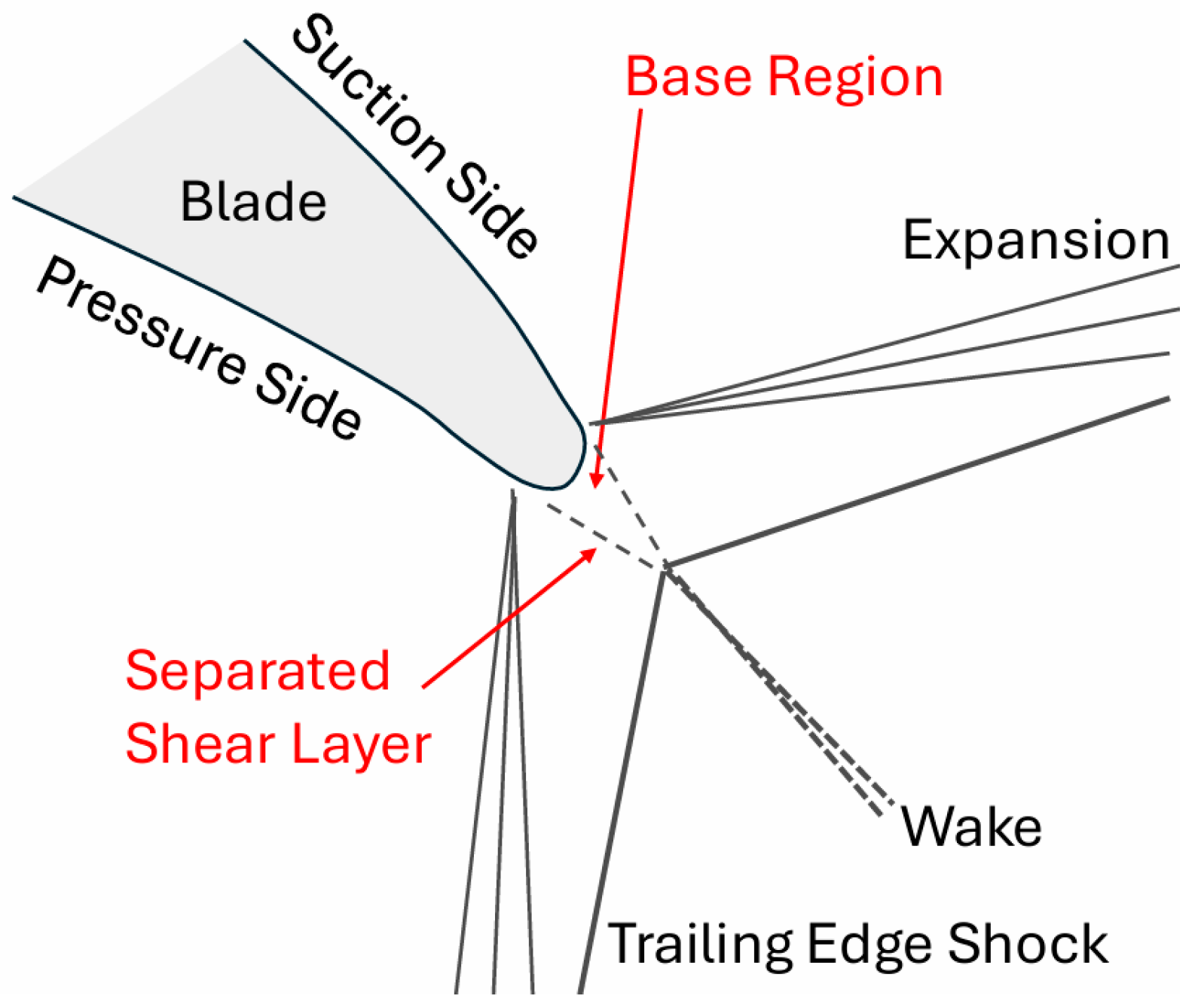

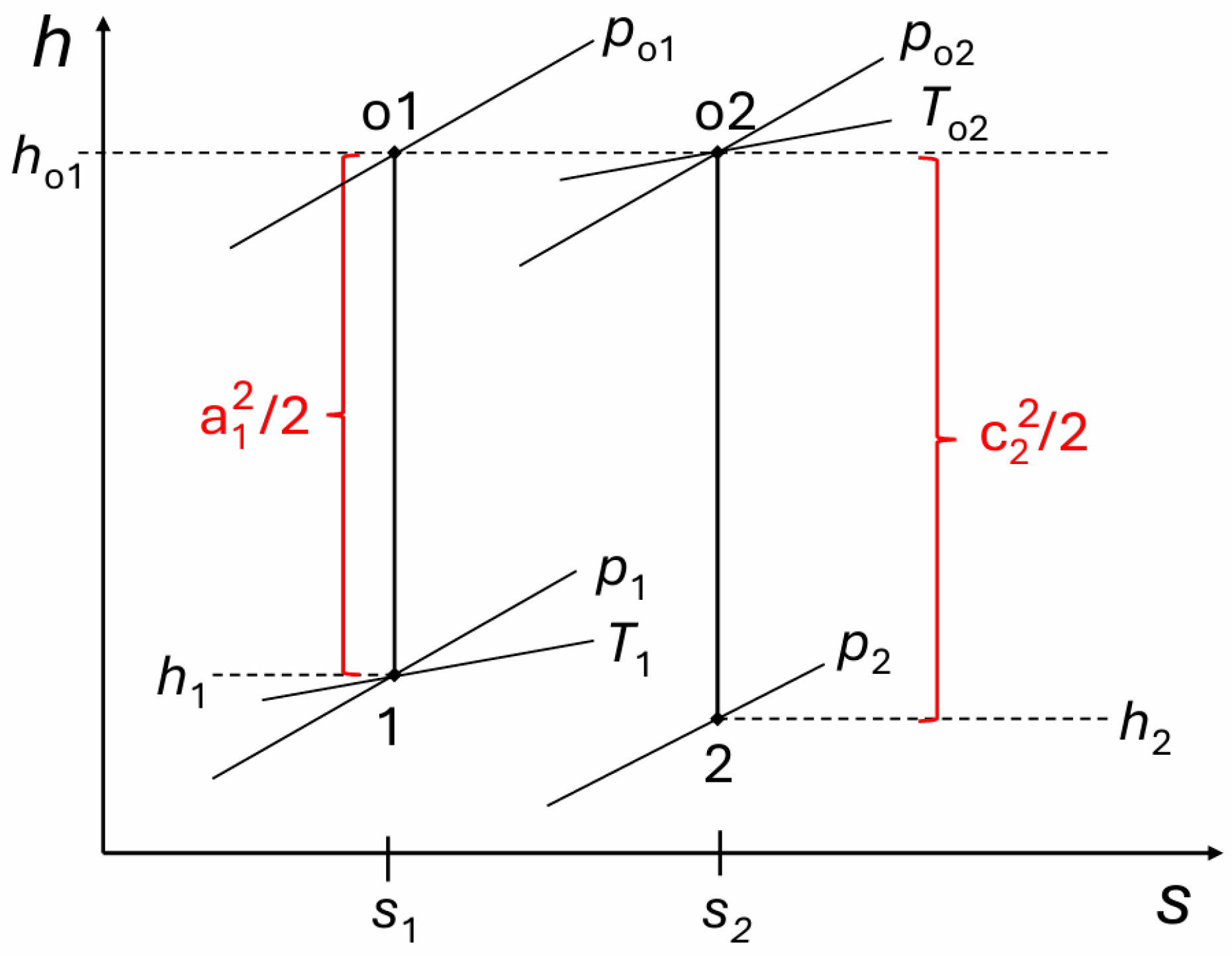
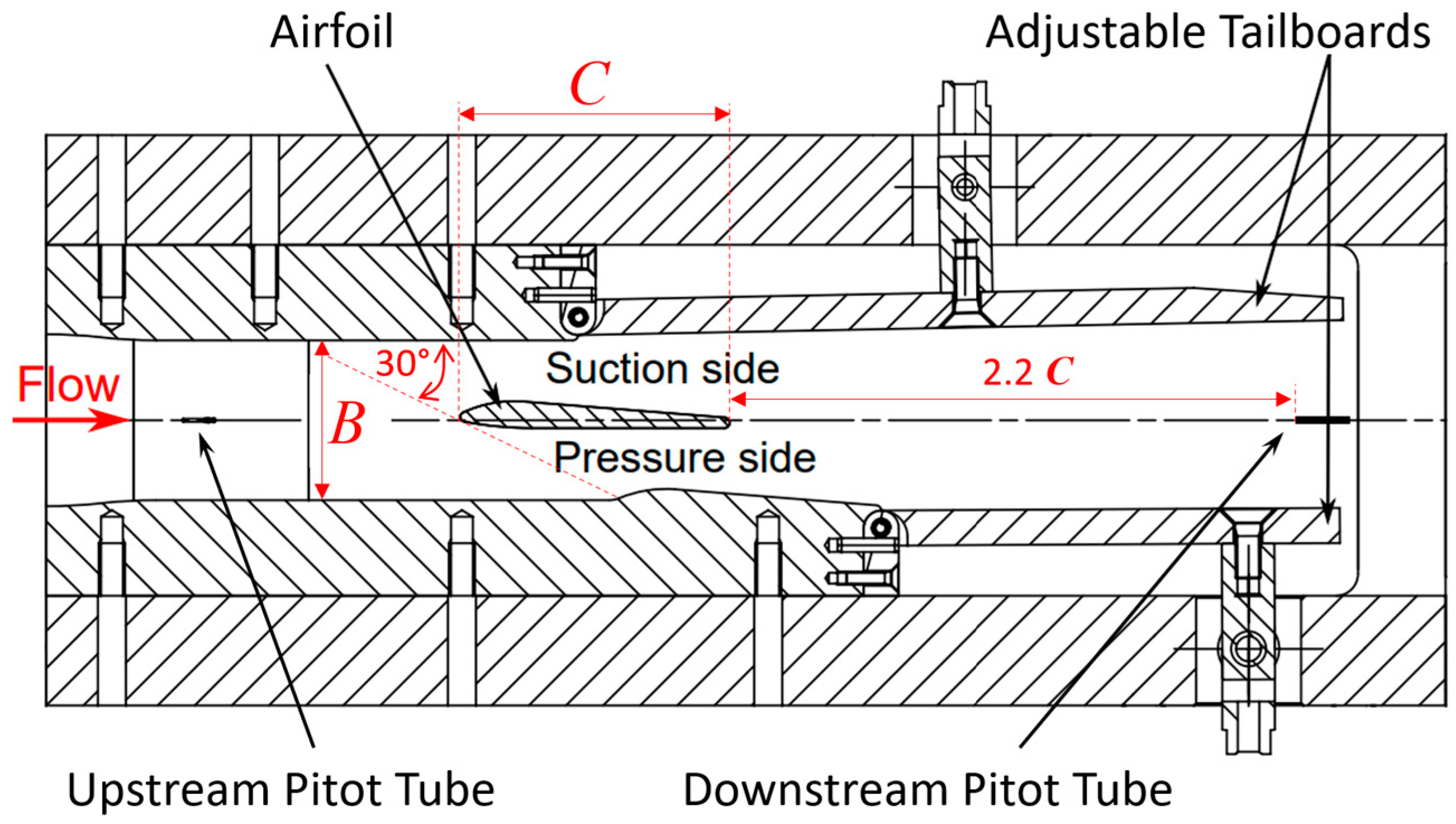
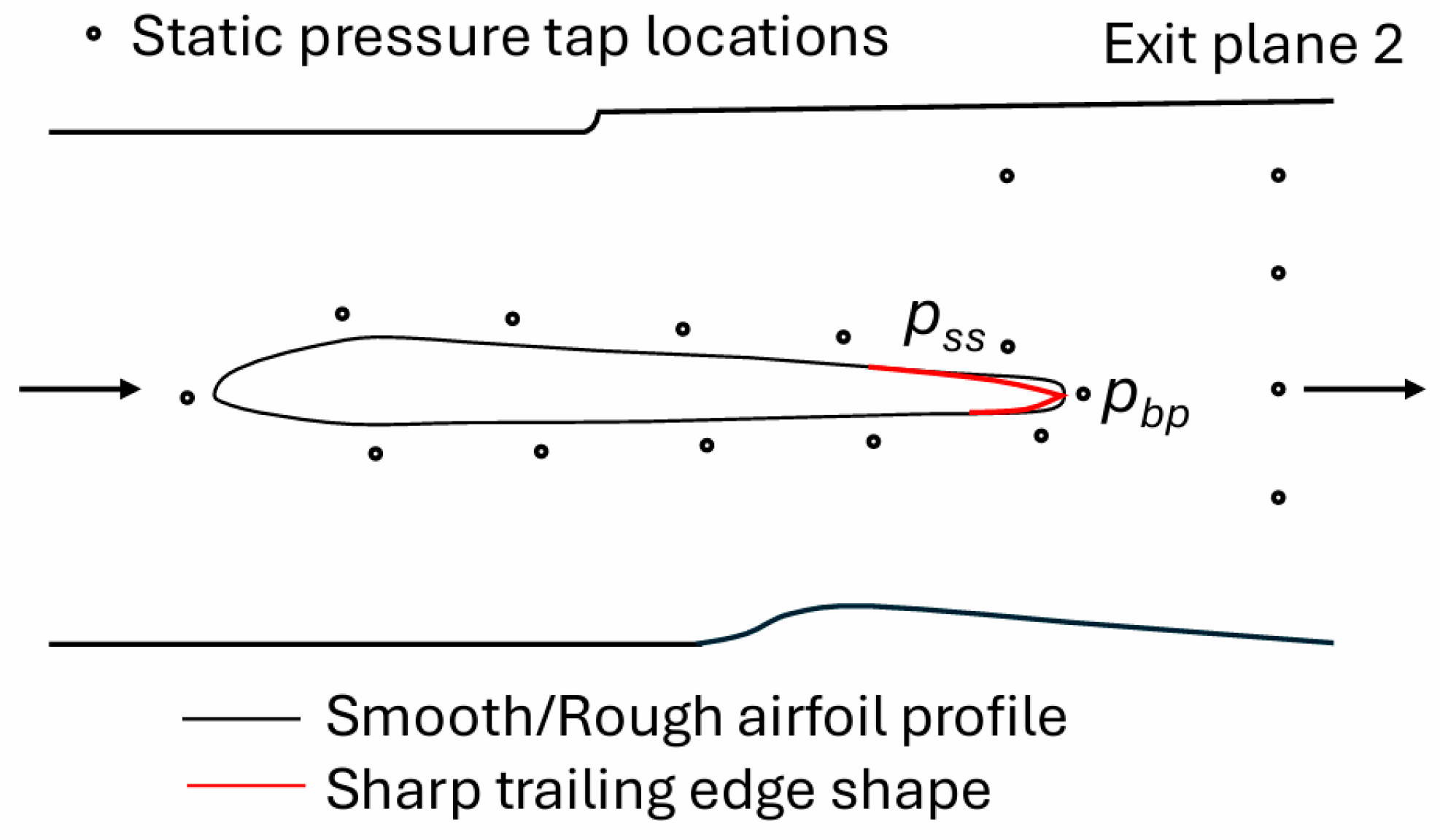

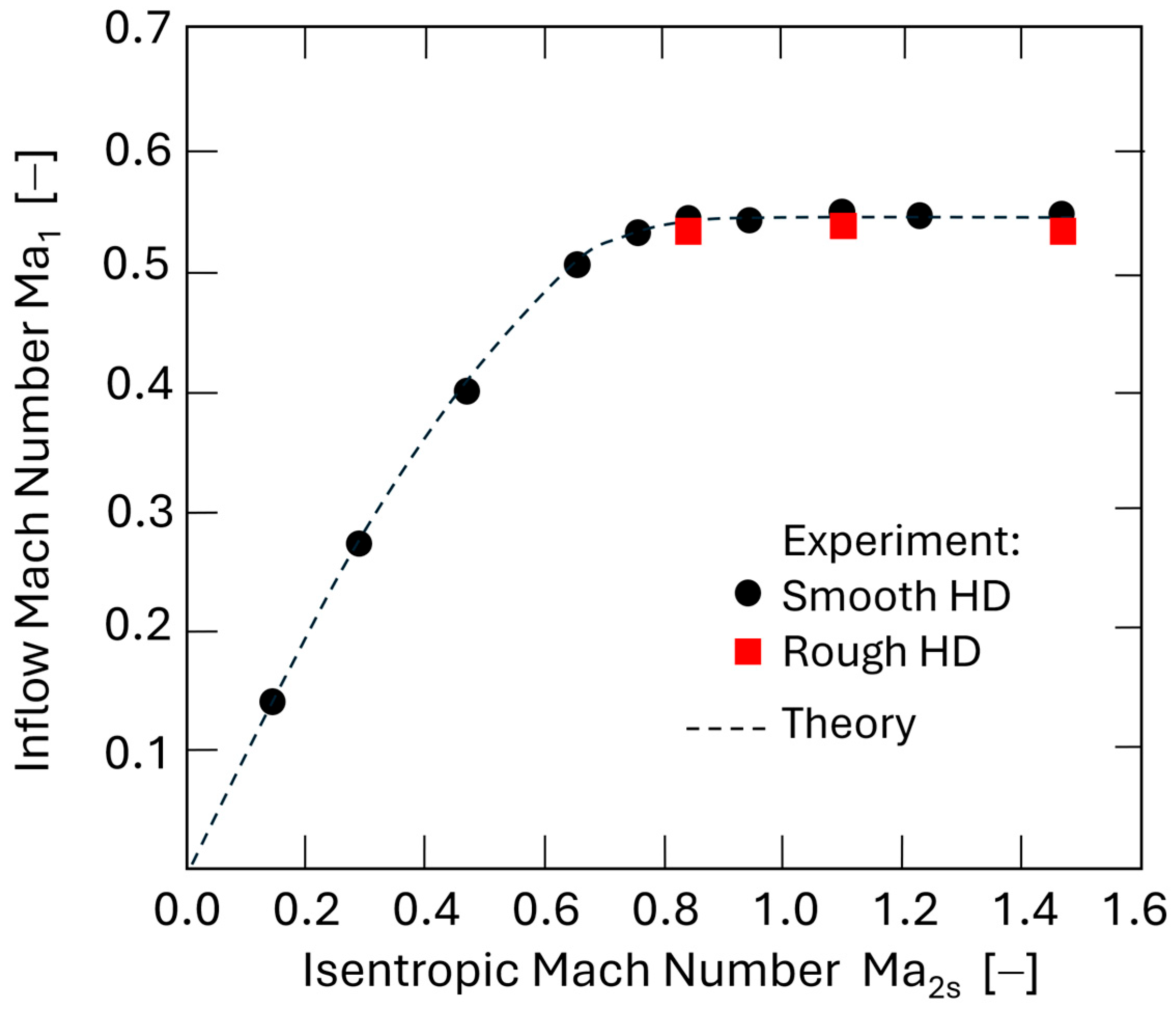
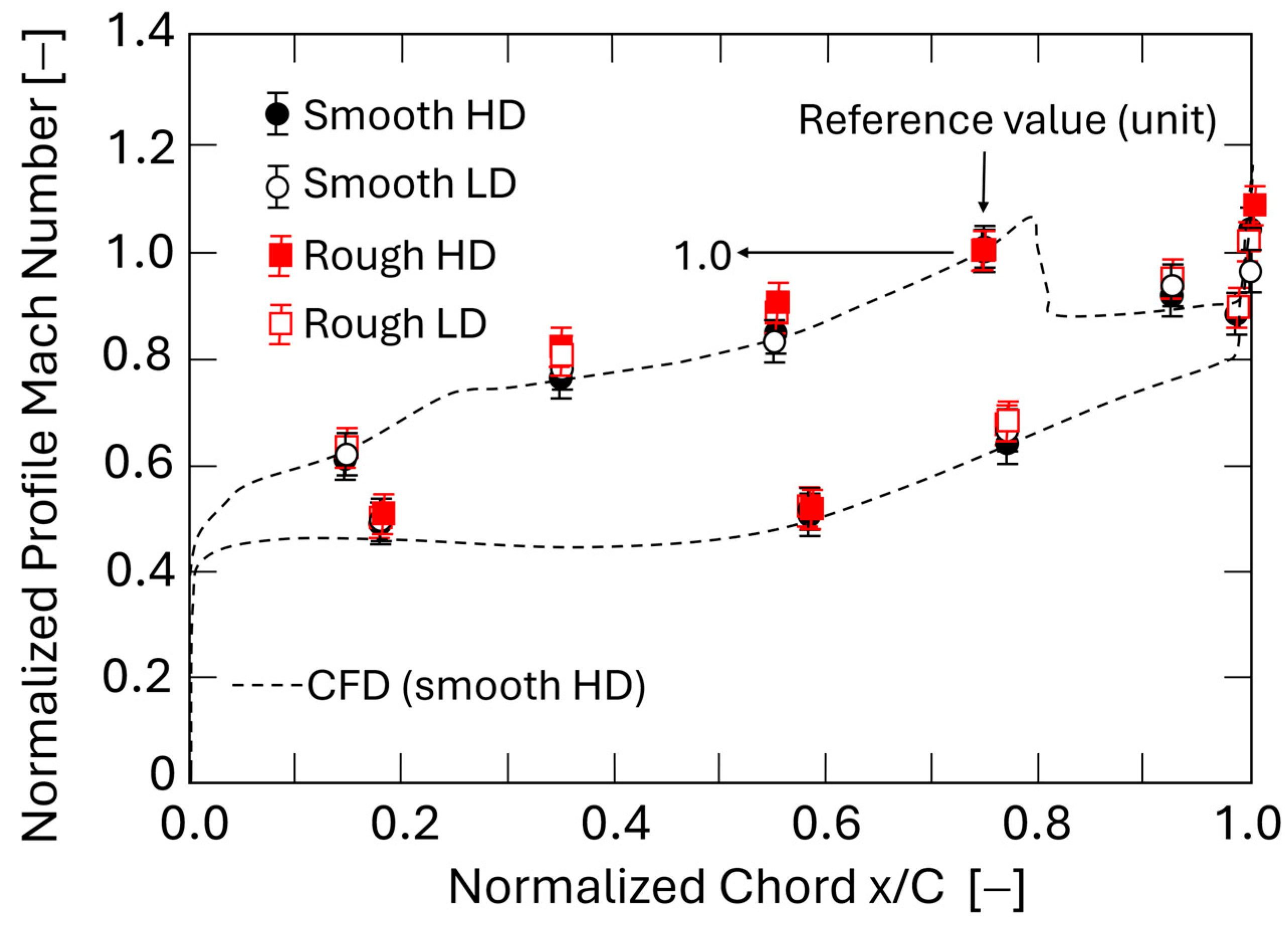
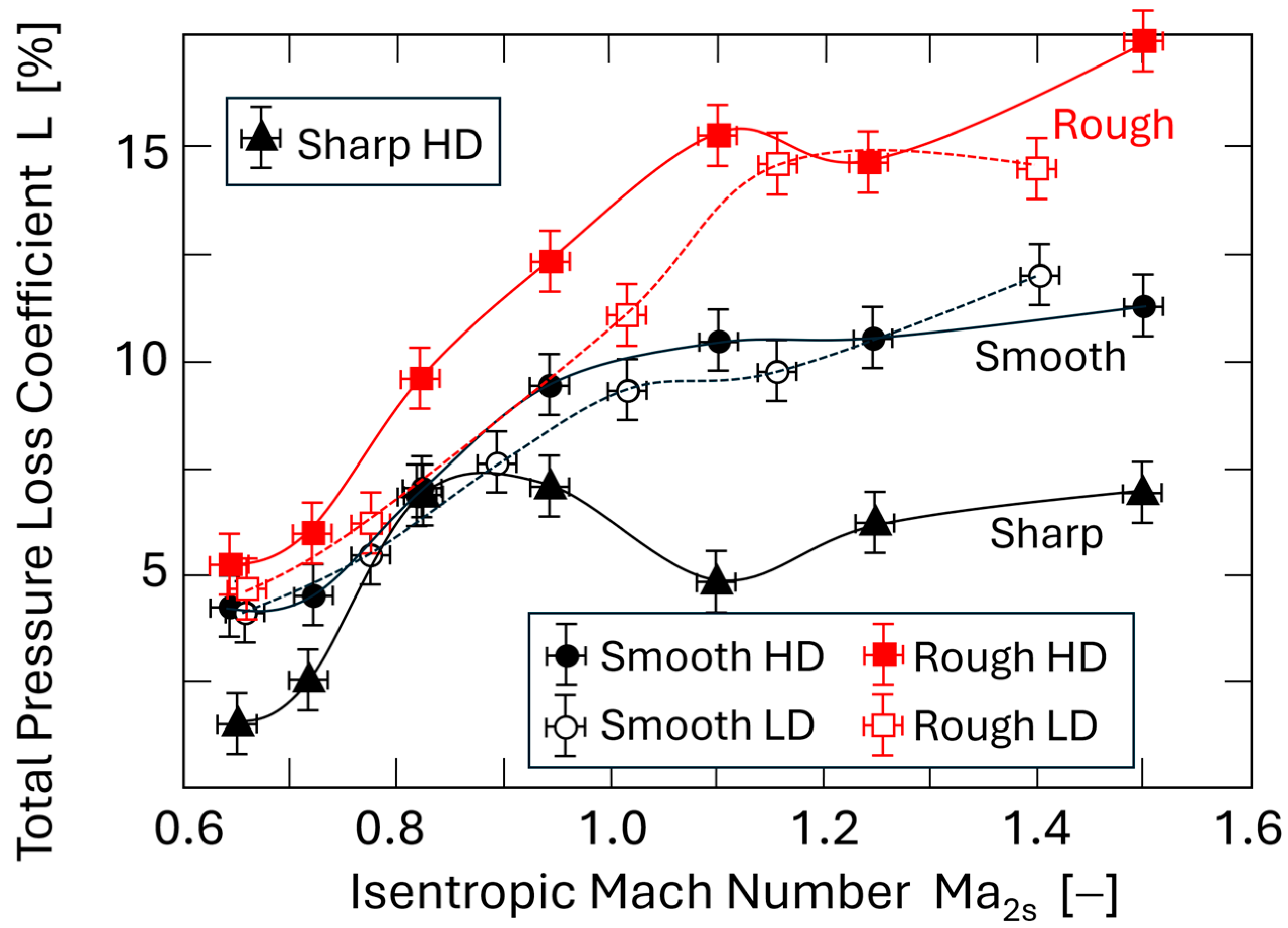
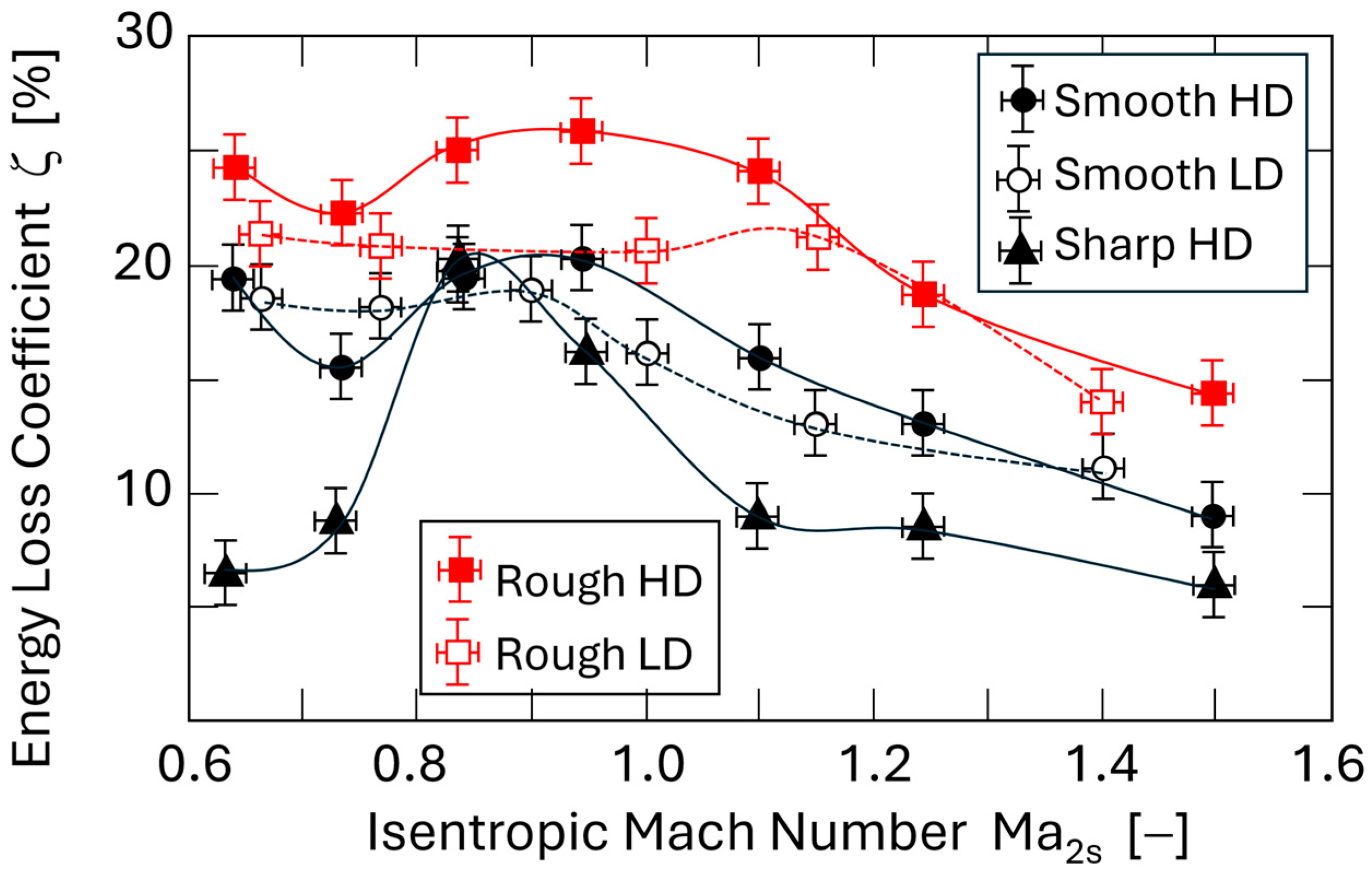
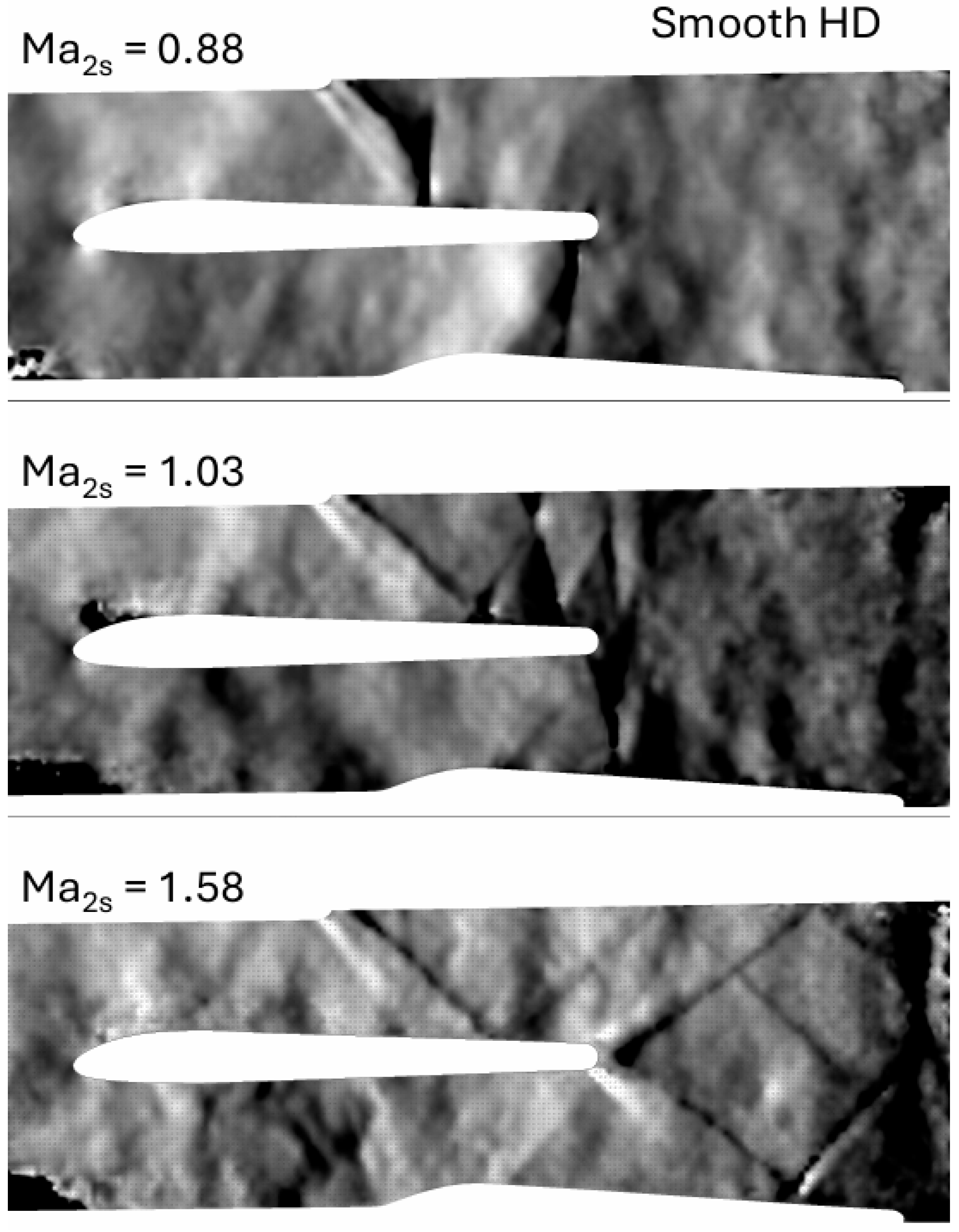
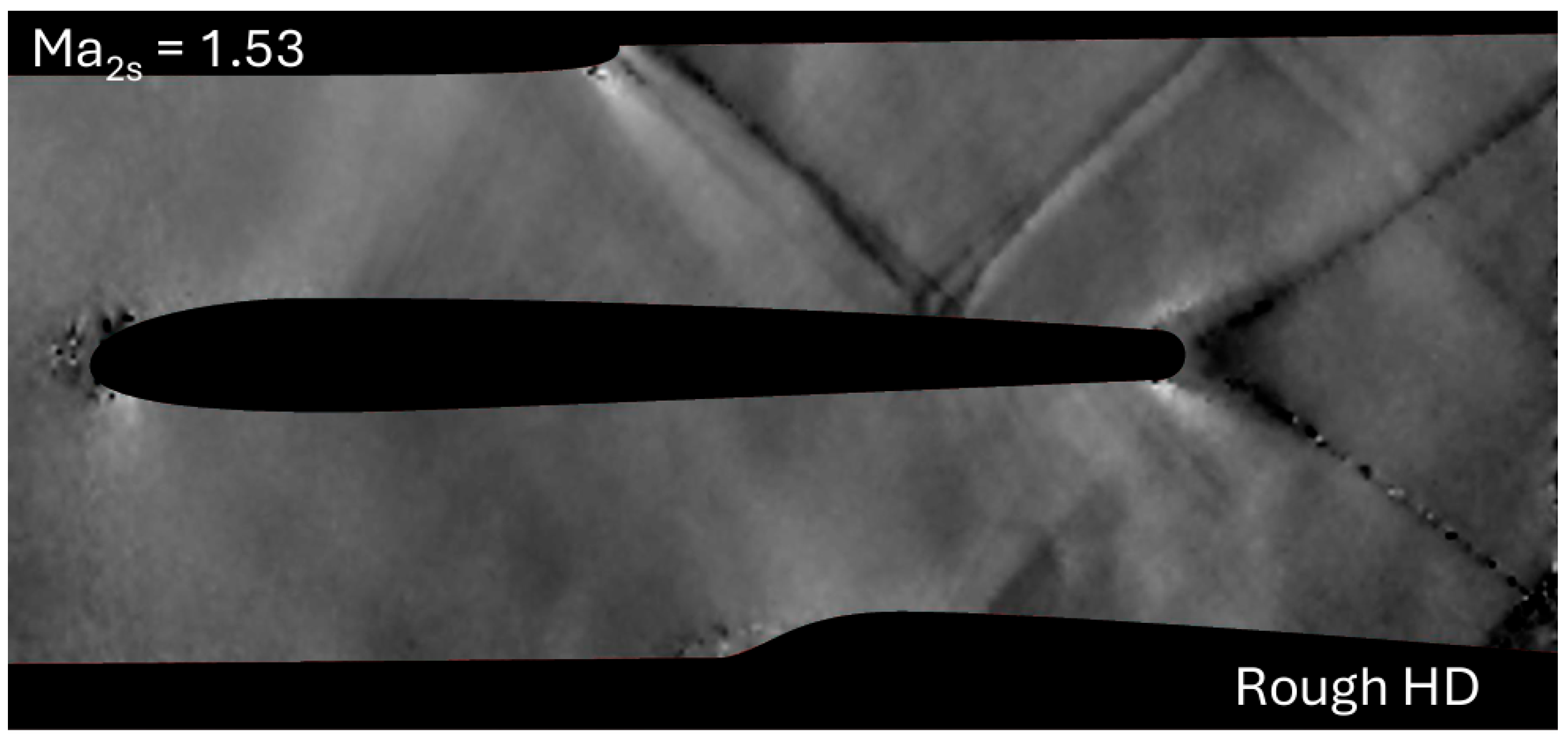
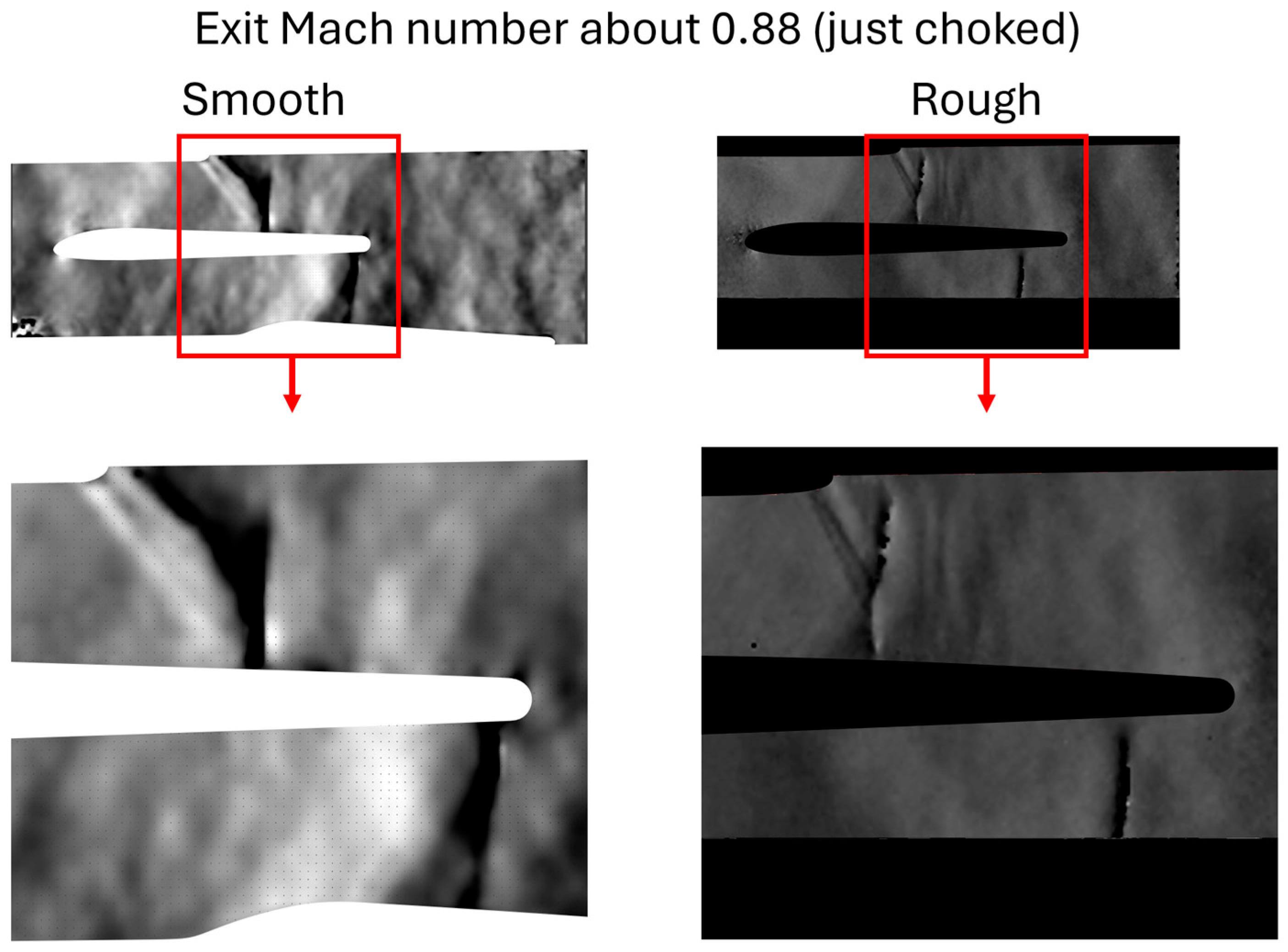


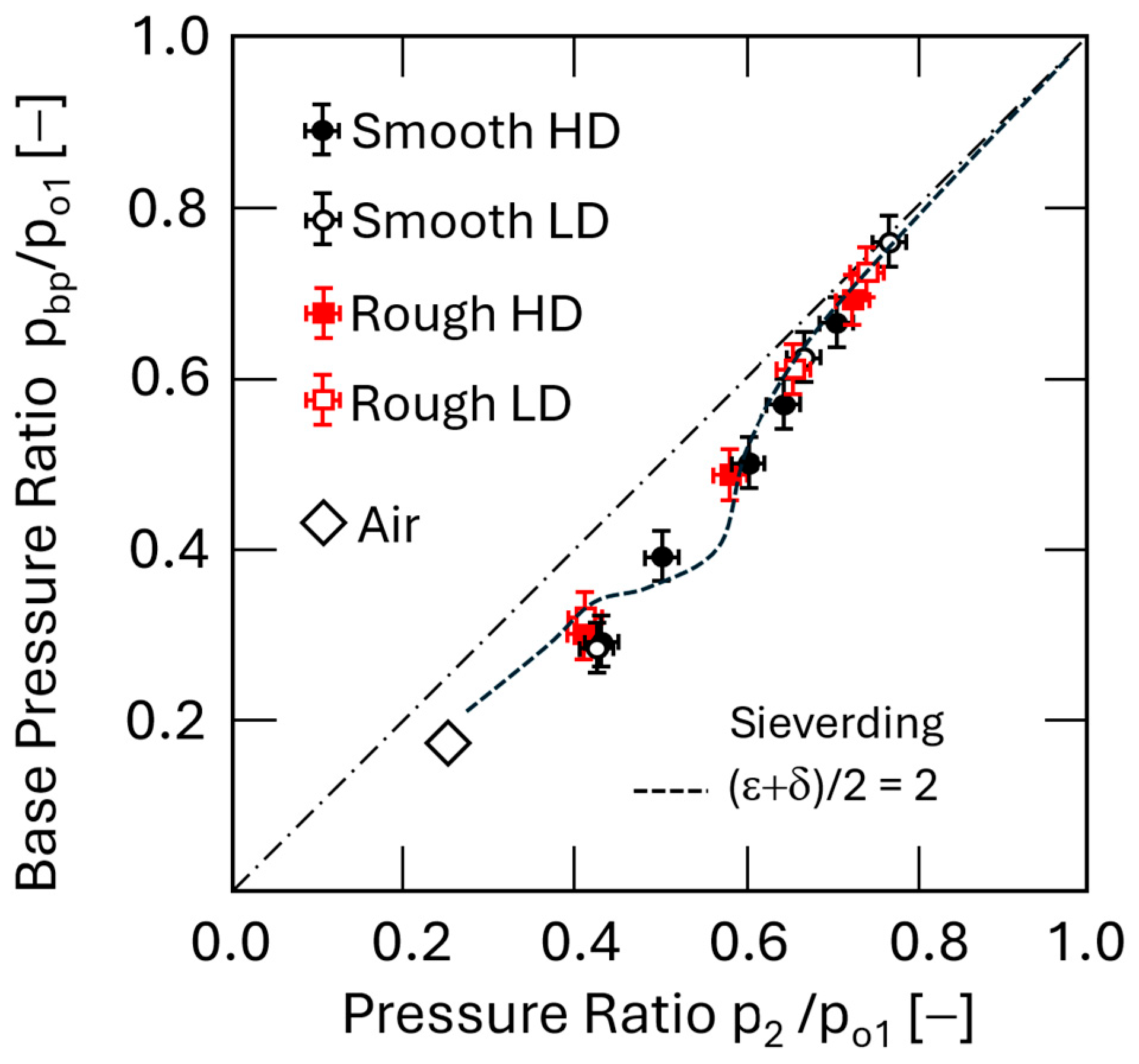
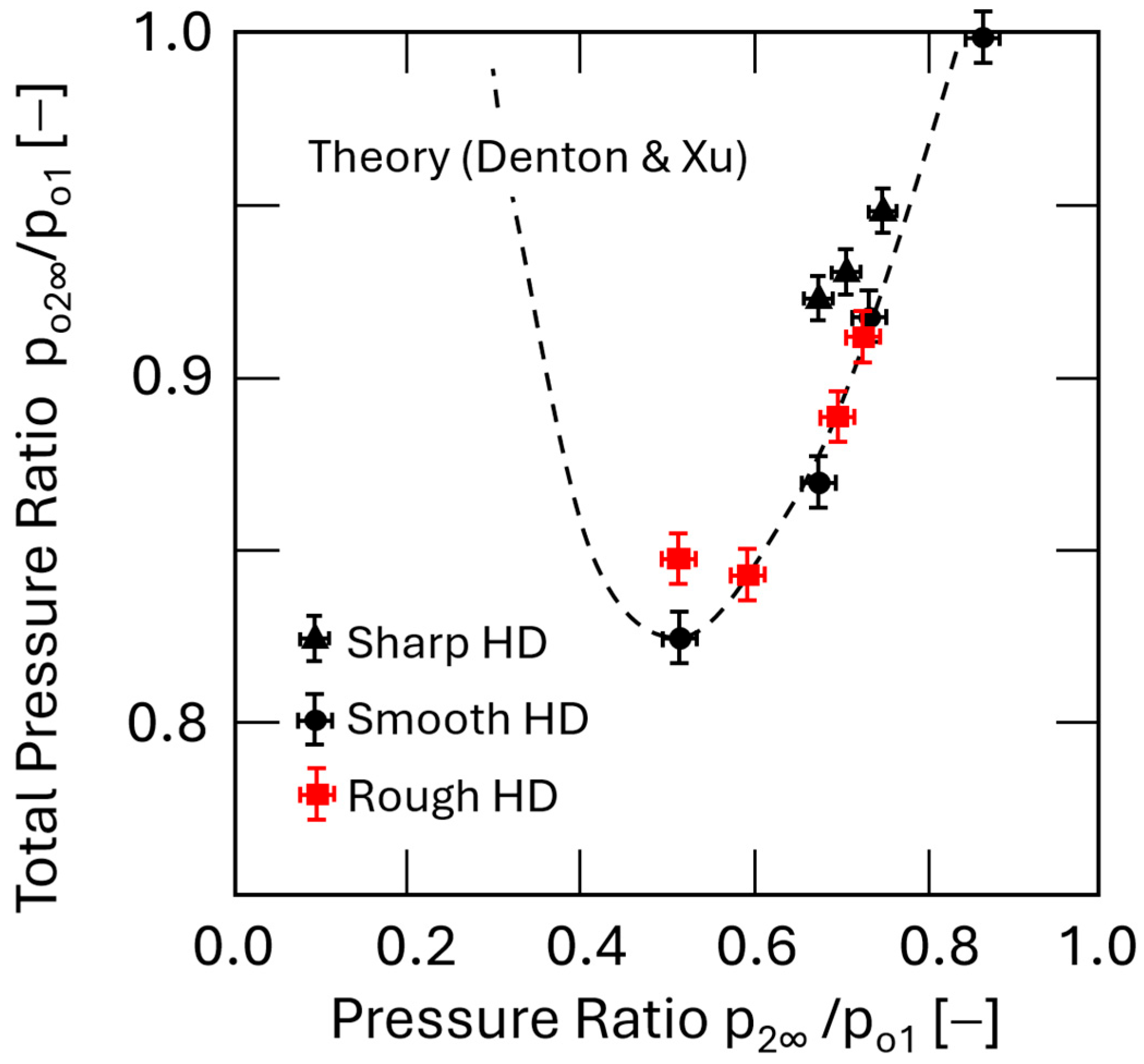
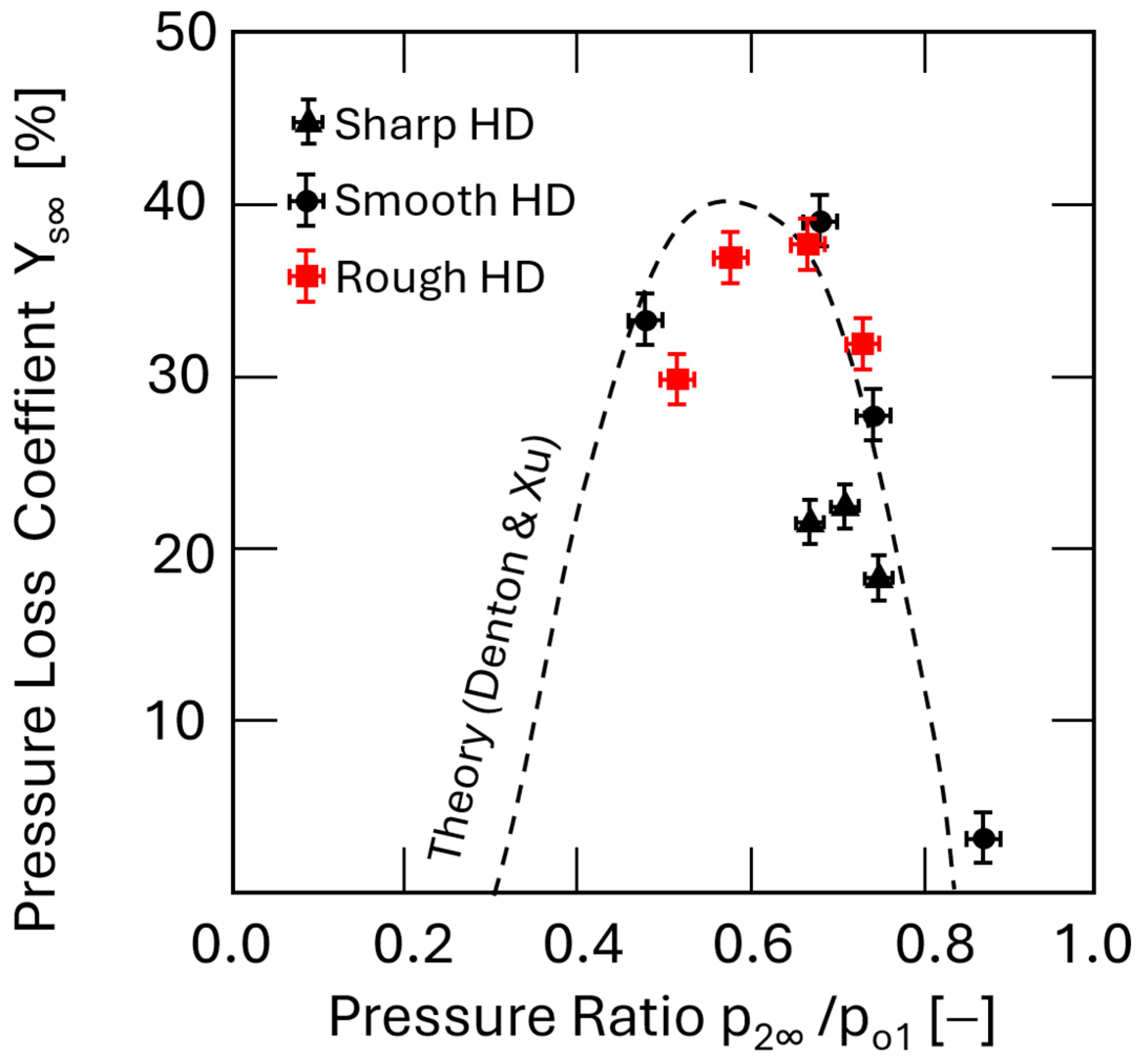
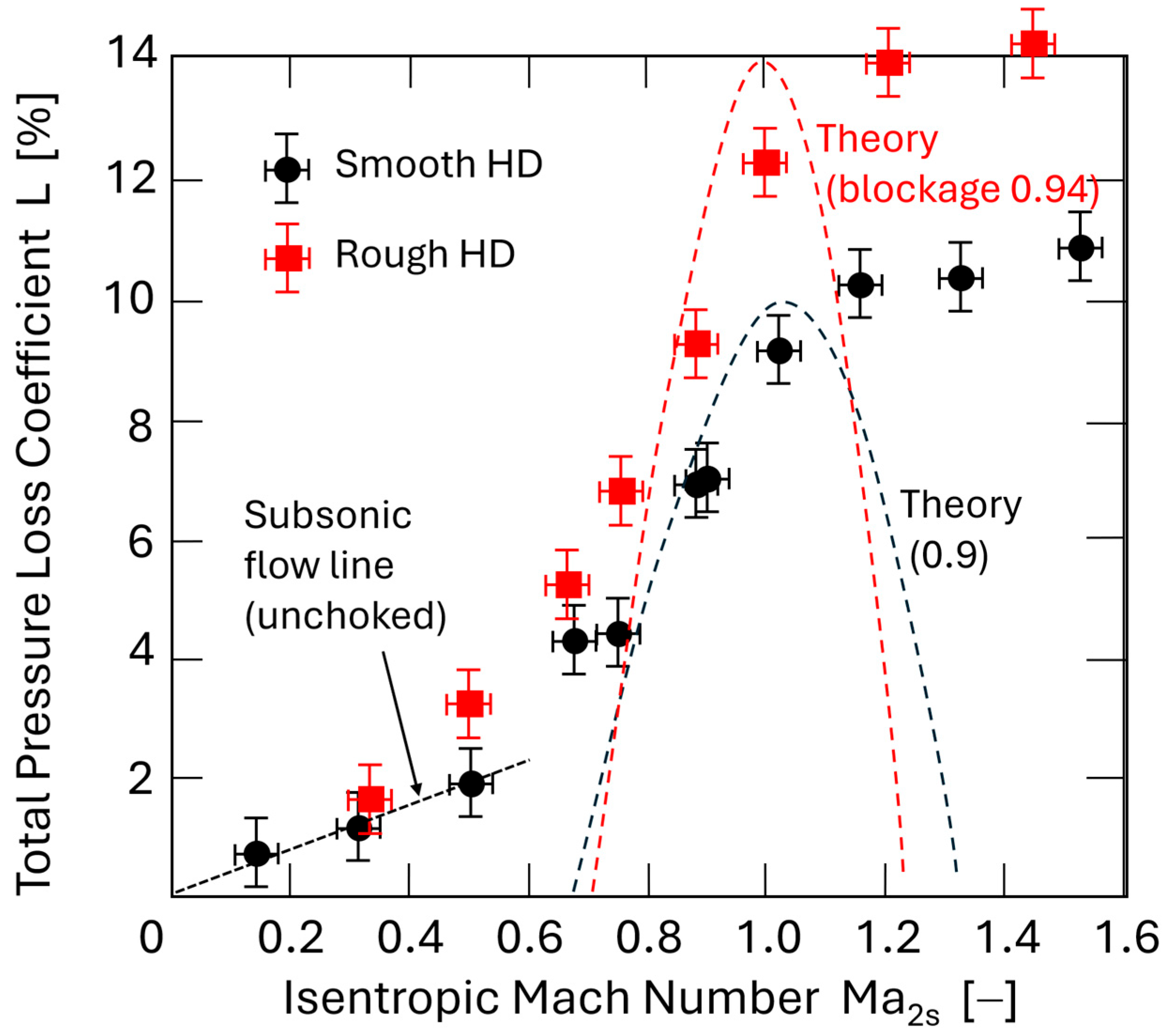

| Chord | C | 61.2 mm |
| Spacing | S | 40.0 mm |
| Stagger angle | β | 60° |
| Blade height (span) | H | 35.0 mm |
| Inlet channel width | B | 36.5 mm |
| Type | Ra [µm] | Rz [µm] | Rt [µm] | Rp [µm] | rTE [mm] |
|---|---|---|---|---|---|
| Smooth | 0.3 | 1.3 | 1.8 | 0.6 | 1.2 |
| Rough | 18.0 | 126.3 | 143.4 | 57.4 | 1.2 |
| Sharp | 0.3 | 1.3 | 1.8 | 0.6 | <0.2 |
| Physical Quantities | Flow Case | HD | LD |
|---|---|---|---|
| Pressure | p [bar] | 2.3 | 1.6 |
| Temperature | T [K] | 383 | 378 |
| Density | ρ [kg/m3] | 25 | 17 |
| Speed of sound | a [m/s] | 94.6 | 95.6 |
| Compressibility factor | Z [−] | 0.92 | 0.94 |
| Isentropic exponent | γ [−] | 1.04 | 1.04 |
| Fundamental derivate | Г [−] | 0.92 | 0.95 |
| Loss Quantity | Method | Value |
|---|---|---|
| Total loss coefficient ζ | CFD [17] | 8.1% |
| Total loss coefficient ζ | Experiment | 9.1 ± 0.6% |
| Denton profile loss ζDen | CFD [17] | 5.5% |
| Trailing edge loss ζte | CFD [17] | 2.9% |
| Trailing edge loss ζte | Experiment | 3.6 ± 0.6% |
| Trailing edge loss ζte | Traupel’s correlation | 2.86% |
| Trailing edge loss ζte | D&T data [27] | 2.8% |
Disclaimer/Publisher’s Note: The statements, opinions and data contained in all publications are solely those of the individual author(s) and contributor(s) and not of MDPI and/or the editor(s). MDPI and/or the editor(s) disclaim responsibility for any injury to people or property resulting from any ideas, methods, instructions or products referred to in the content. |
© 2025 by the authors. Published by MDPI on behalf of the EUROTURBO. Licensee MDPI, Basel, Switzerland. This article is an open access article distributed under the terms and conditions of the Creative Commons Attribution (CC BY-NC-ND) license (https://creativecommons.org/licenses/by-nc-nd/4.0/).
Share and Cite
Hake, L.; aus der Wiesche, S. Trailing Edge Loss of Choked Organic Vapor Turbine Blades. Int. J. Turbomach. Propuls. Power 2025, 10, 23. https://doi.org/10.3390/ijtpp10030023
Hake L, aus der Wiesche S. Trailing Edge Loss of Choked Organic Vapor Turbine Blades. International Journal of Turbomachinery, Propulsion and Power. 2025; 10(3):23. https://doi.org/10.3390/ijtpp10030023
Chicago/Turabian StyleHake, Leander, and Stefan aus der Wiesche. 2025. "Trailing Edge Loss of Choked Organic Vapor Turbine Blades" International Journal of Turbomachinery, Propulsion and Power 10, no. 3: 23. https://doi.org/10.3390/ijtpp10030023
APA StyleHake, L., & aus der Wiesche, S. (2025). Trailing Edge Loss of Choked Organic Vapor Turbine Blades. International Journal of Turbomachinery, Propulsion and Power, 10(3), 23. https://doi.org/10.3390/ijtpp10030023





